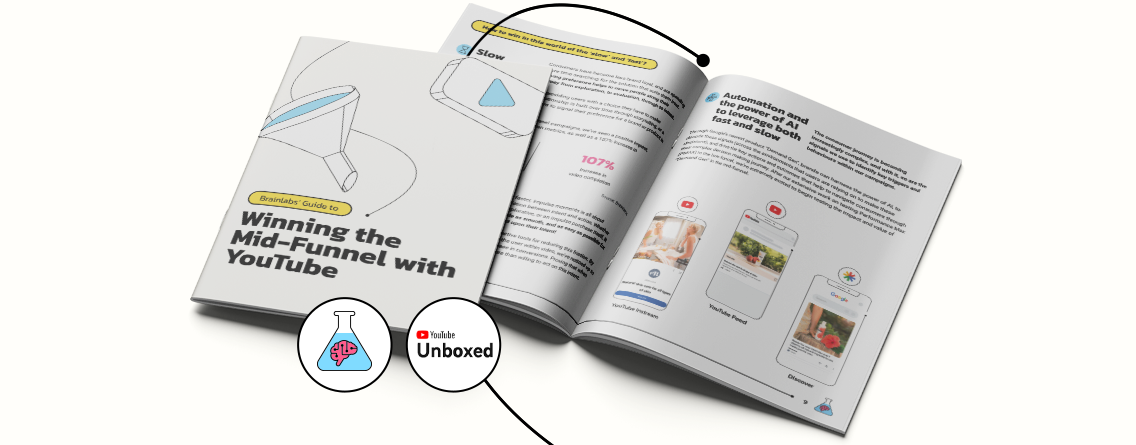Introduction
The combination of a more fragmented media landscape, a ‘messier and more confusing’ shopping journey and more fickle consumers means planning across the funnel has never been more complex. But, importantly, we’ve also never had more exciting tools and technology at our disposal.
YouTube has an important role to play in this ever-fragmented world. People are finding the content they love on YouTube and watchtime across screens is soaring, so, defining the right AV strategy that flexes with audience behavior is key to brands’ success.
With more data signals to activate and more targeting and formats to play with – we’ve built out our top tips for marketers who want to win on YouTube.
Contents
- The Mid-Funnel is the Battleground
- Building a holistic AV strategy
- Level up your creative for the Mid-Funnel
- Harnessing the power of YouTube Shorts
- Delivering an effective measurement strategy
- Our top takeaways for brands
The Mid-Funnel Battleground
As media becomes more digitised, a conventional split between ‘brand-building/upper-funnel’ and ‘performance/lower-funnel’ is too arbitrary and ignores the nuance of the modern consumer journey.
Whilst the mid-funnel is widely considered a battleground, we believe it’s more of a fertile ground – where there’s a plethora of untapped opportunities and where the traditional rules of marketing don’t apply.
Read on for the key findings from our trademark, experimentation-led approach to this messy mid-funnel, plus our own rules for how to win.
Growing openness to try new, unfamiliar brands, and declining brand loyalty
Recent research by Google into the ‘Messy Middle’ shows that in multiple categories, ranging from low interest categories like shampoo to more high consideration categories like TV and car insurance, over 50% of consumers said they are more likely to choose a fictional brand over one they were familiar with.
How exactly is the consumer journey changing?
Source: Google Messy Middle Research
Brand consideration is an increasingly critical lever across categories
We’ve conducted Correlation Analysis across a number of brands and categories and results from our analysis consistently showed brand consideration to have the highest correlation with purchase intent.
Source: Brainlabs Correlation Analysis
Consumers show ‘slower’ behaviours when discovering and exploring
1 in 3 consumers research online before making a purchase. The number of generic searches on Google and YouTube has grown massively, whilst YouTube watchtime for terms such as “best moisturizer” grew +121% in the last year . As consumer spending becomes more discerning, there is either more demand for great value, or high product efficacy to make sure what they’re buying is worth the money.
- ? 1 in 3
Are researching more online before purchasing - +121%
YouTube watchtime for videos with ‘best moisturizer’ in title
Source: Google
More uncertain consumers to play for in the consideration phase
Our analysis of the consumer journey using search keyword data, showed that the consideration phase of the journey drives the highest volume of interest. Proving that there is huge growth in exploration and evaluation searches and in particular, in the hunt for ‘the best’ and ‘cheapest’.
| Best | Cheap | |
|---|---|---|
| Finance | +74% | +32% |
| Travel | +33% | +4% |
| Overall | +13% | +33% |
Source: Google
Video, and YouTube in particular, plays a key role in both slower category exploration, and fast, impulse purchasing
YouTube accounts for 94% of all online audiences alongside granular targeting opportunities – which means there is opportunity for both scale and narrow targeting.
The contextual opportunities available in YouTube, allows advertisers to be present in, and intercept those key, category trigger & exploration moments, more so than in social environments. In addition, the evolution of shoppable capabilities within YouTube provide opportunities to reduce friction, and shorten the gap between evaluation and action.
- 41% Younger consumers impulse buy regularly
- 50% Impulse buy to take advantage of sales/ deals
- 40% Impulse buy to treat themselves and for ‘fun’
Source: GWI 2023
At the same time, we’re noticing faster decision-making as impulse purchasing grows
Thanks to the rise in social shopping and quick commerce apps, 41% Gen-Z and Millennials make an impulse purchase online every 2-3 weeks. Now more than ever, we’re witnessing the ‘lipstick effect’ in action and the ever-growing need for ‘instant gratification’.
Source: Google
41%
of Gen Z & Millennials make an impulse purchase online every 2-3 weeks
- Unboxing Hauls
- Product Reviews
- How-To Tutorials
- Product Drops
How to win in this world of the ‘slow’ and ‘fast’?
Slow principles
Consumers have become less brand loyal, and are spending more time searching for the solution that suits them best. Driving preference helps to move people along their journey from exploration, to evaluation, through to intent.
Whether this preference is built through providing users with a choice they have to make (signalling a preference), or whether a relationship is built over time through storytelling, or a combination of the two – driving more users to signal their preference for a brand or product is how we win in these moments.
When testing these strategies in the mid-funnel campaigns, we’ve seen a positive impact, with an average 42% increase in consideration metrics, as well as a 107% increase in video completions.
Source: Brainlabs
- 42% Average increase in Consideration metrics
- 107% Increase in video completion
Fast principles
Winning in the faster, impulse moments is all about reducing the friction between intent and action. Whether this action is explorative, or an impulse purchase itself, it needs to be made as smooth, and as easy as possible for consumers to act upon their intent!
Video Action Campaigns and shopping feeds are effective tools for reducing this friction. By prompting further action, or bringing the storefront to the user within video, we’ve noticed up to 267% increase in engagements, as well as a 60% increase in conversions. Proving that when users are moving from evaluation to intent, they are more than willing to act on this intent.
Automation and the power of AI to leverage both fast and slow
The consumer journey is becoming increasingly complex, and with it, so are the signals we use to identify key triggers and behaviours within our campaigns.
Through Google’s newest product “Demand Gen”, brands can harness the power of AI, to decode these signals (across the environments that users are relying on to make these decisions), and drive the key actions and outcomes that help to navigate consumers through their complex decision making journey. After our extensive work on testing Performance Max (PMAX) in the low-funnel, we’re extremely excited to begin testing the impact and value of “Demand Gen” in the mid-funnel.
- YouTube Instream
- Discover
- YouTube Feed
Principles for a Modern AV Landscape
Read on to see our experts top three tips on measurement, creative and AV Planning to drive unbeatable results for your brand on YouTube.
The Power of Three
Building a holistic AV strategy
Ad spend should reflect consumer behaviour, but that doesn’t have to mean dropping traditional media entirely. Marketers should consider the most cost effective ways of reaching their audience and plan AV spend holistically, allocating budget based on audience consumption, quality and effectiveness.
A holistic AV planning and buying ecosystem is built on three core principles.
1 Be connected
The AV landscape is changing based on audience consumption habits. Effective AV planning should account for the way consumer viewing is changing across all platforms plus the different need states and attention. Brands need a connected approach to AV that plans and measures video holistically, focusing on attentive reach, as opposed to a broadcast approach that leads to exorbitant wastage.
We recommend that brands plan and measure AV with three key inputs in mind: audience reach, quality and effectiveness. This ensures budget is focused on where your audience are spending their time and reaching them in high attention environments, with media that has proven results on your business outcomes.
2 Be predictive
Use real time insights and custom bidding to power addressability cross channel and deliver against outcomes.
Digital-first insights should inform your AV creative and messaging, with an agile approach to generating responsive creative based on the latest trends. AI can be used to speed up this process and help with briefing as well as creative concepting.
3 Be relevant
Accelerate AV performance through creative experimentation. Set both micro and macro hypotheses to test throughout your campaign and adapt your approach in- flight, based on learnings.
This could be a format test, such as introducing CTV into your buying strategy, or understanding if including dynamic or interactive elements within your format approach, drives higher engagement.
Use custom bidding and KPIs to optimise your AV towards goals that you predict will drive outcomes for your business – whether that be quality traffic to site or email sign-ups. Brainlabs’ correlation analysis can be used to help hypothesise which metrics will have the greatest impact.
Level up your creative for the Mid-Funnel
Creative remains one of the best vehicles for competing with an oversaturated market – especially in the mid-funnel. Thankfully, we now have technology at our disposal, that allows us to be reactive and responsive at scale and at pace. .
When planning for creative in the mid funnel, there are three key principles that inform our process.
1 Understand your audience intent
The self-selecting nature of the YouTube platform makes it a powerful lever to determine user intent and psychology, whilst allowing you to predict the video content and creators that will most resonate with your audience. This not only applies to how consumers actively search and interact with organic content, but also to paid advertising. For example, if users decide not to skip an advert, they’re making an active choice to view content which can be used as an indicator of preference.
Your first step should be to better understand and segment your audience, whilst dissecting their intent and exploration behaviour to inform your creative concepting.
Shopping feeds in VAC
2 Increase relevance & reduce friction
Tailor your creative to your audience’s intent signals to increase relevance. Whether that’s based on the content they’re about to watch, the latest trends and conversations they’re engaging with, or a content creator they follow. The fast and slow nature of the messy middle means that creative experimentation and shopability is key to cut through and capture conversions as users move swiftly to purchase.
Sequential messaging can be used as a device to serve multiple messages and test which creative resonates best and drives action. Integrating shopping feeds within formats can also help to bridge the gap between evaluation and action.
3 Be disruptive to grab attention
Experiment with creative formats and messaging to grab attention. The contextual power of YouTube means that you can have fun with your messaging and use this as a lever to add value to the user experience, rather than detract from it.
This could include playful messaging around the skippable element, using an influencer that audiences are expecting to appear organically in your ad creative, or even experimenting with long-form content that truly educates or entertains, rather than just an ad.
Shopping feeds in Creator Promotions
Harnessing the power of YouTube Shorts
YouTube Shorts offers brands the opportunity to tap into the platform’s already-massive user base and reliable engagement performance.
However, to truly make the most of your YouTube Shorts activations, there are three things marketers should consider when creating content.
YouTube Shorts
1 Keep it short and sweet
The clue is in the name. Whilst YouTube is the destination for long- form content, the Shorts format is growing rapidly thanks to their ability to deliver the payoff quickly. Set it up, and nail the punchline or payoff in 15 seconds for the optimum View Through Rates.
2 React early & win with trends
YouTube Shorts thrive on trends and challenges, so it’s essential for marketers to stay updated with the latest viral trends and incorporate them into their content. Monitor the popular Shorts on the platform and identify trends that are relevant to your target audience or industry.
By participating in challenges or creating content that aligns with trending topics, you can increase the likelihood of your videos gaining traction and reaching a wider audience.
- #housetour
- #ASMR
- #getreadywithme
- #beautyreviews
- #nightroutine
- #storytime
- #outfitoftheday
3 Tell them what you’re going to tell them
While Shorts can be discovered through various means, including the Shorts shelf, the YouTube homepage, and through search results, it’s important to optimize your content for maximum discoverability. Use relevant keywords in your title, description, and tags to improve the chances of your Shorts appearing in search results – be clear on what the payoff for the audience is.
Additionally, leverage hashtags related to your content to increase visibility within the Shorts ecosystem. Focus on creating high-quality thumbnails that are eye-catching and clearly represent the content of your video.
Delivering an effective measurement strategy
Data continues to be one of the most valuable assets in marketing, but it’s not being effectively utilised throughout the industry – and this needs to change.
Brands continually measure success using rule based solutions, omitting the most valuable opportunities such as incrementality, losing out in understanding what is really driving change from media. Success is driven by an effective measurement solution, made up of three key elements.
1 Build a clearly defined Measurement Framework
Whilst in marketing we talk about moving consumers through the funnel, it’s also important that we measure the effectiveness of a campaign on its campaign goal. When running a YouTube campaign to drive consideration, measure the impact against the business measure of consideration, rather than conversions. A clear measurement framework will focus activity on what the business identifies as successful – from awareness through to conversion and loyalty.
Only then, can you identify the paid, owned and earned metrics that help to drive these business outcomes, whilst giving marketing teams and partners a view of trading performance at a more granular level.
2 Experiment with Geo-Based Incrementality Testing
The strongest determinant of a campaign’s success is its ability to turn customers who had no intent to purchase into converting customers. Marketing’s role is to drive growth, and whilst a platform’s conversion is a widely utilized measure of success, it regularly accounts for those users who would have purchased anyway.
Geo-based incrementality testing allows you to test various channels, tactics and audiences on a geographic basis using its test-control methodology. This can determine the incremental impact each form of media drives on brand-led success metrics (including sales), empowering brands to learn faster and be smarter with their budgets going forward.
3 Bring certainty to advertising with Econometrics
Econometrics. Arguably the most impactful measurement of media effectiveness but also the most traditional of solutions. However, its use has picked up significantly with the expansion of digital into a through the funnel solution.
The beauty lies in being able to determine the overall impact of media on broader business outcomes over a multi-year period, whilst showcasing the incremental value the activity drove above and beyond your average metrics. This provides teams with channel-specific response curves, and data-driven insights on how best to utilize YouTube budgets in the future.
Key measurement solutions to help drive through the funnel insights
Our top takeaways for brands
Navigating today’s dynamically changing consumer and media landscape can be challenging. Employing the right strategy, that includes video planning, measurement and creativity, can not only drive business growth, but also provide competitive advantage for your brand.
In partnership with Google, we’ve compiled our top five ways to win on YouTube
Use the right combination of YouTube and it’s AI powered solutions to deliver scale and relevance to your target audience
Whilst the media landscape is fragmented , 79% of people say that YouTube has unique content that they can’t find anywhere else.This means that YouTube is the #1 platform for content that is relevant and personal to people in the UK. Whatever your target audience, they can be found on YouTube.
With this in mind, it’s fundamental that advertisers work with YouTube and its AI powered solutions in an AV capacity to marry up a cohesive presence that delivers scale and relevance to their audiences.
Plan your video spend holistically to respond to changing needs across the entire customer journey
Plan your AV budget with three key inputs in mind: audience reach, quality and effectiveness. These metrics will change throughout the consumer journey and your channel and format mix will shift as a result.
In the awareness stage, plan your budget to focus on attentive reach over broadcast based on changing consumption habits. In the consideration and conversion stages, plan your budget to focus on addressable in-market reach, and use indicators of consumer preference and frictionless formats to successfully navigate the slow and fast moving nature of the journey.
Accelerate performance through creative experimentation
Creative is one of your biggest levers to drive performance in an increasingly automated world. Optimize your creative with as much consideration as you optimize your media and harness the power of platform’s innovative formats, such as YouTube Shorts to extend your reach to a highly engaged user base. Use real time audience insight and trends to increase relevance, and experiment with micro and macro hypotheses to understand what works.
As the number one driver of ROI, the right creative is creative that understands your target audience. Use Google to mine for insights to power your YouTube creative as well as utilizing the exciting world of creators, formats or data triggers in order to drive growth.
‘Community’ is gold dust for brands and creators are the gate-keepers
According to Google’s Mirrors & Windows Report, YouTube is the place the UK most feels like they can find and watch content that is personally relevant to them or dig deep into their interests and passions.
Media has an important role to play in fostering a sense of inclusion and people want content that makes them feel part of a like-minded community. Niche content can create incredibly powerful associations when it resonates with viewers.
Advertisers should look to avoid unconscious bias in media delivery by reviewing keyword or topic exclusions or consider running an inclusive media minilab with Google to help support a more representative and equitable creative economy.
Measure and optimize to the outcomes that matter
Set a clear measurement framework that is relevant to your own defined measures of success or business needs. This could be anything from awareness to conversion, sales or brand loyalty – or indeed a balance of them all.
Ensure all tests and media are planned and optimized towards this outcome, and experiment with custom bidding to increase effectiveness. For a more macro- focused read on performance, use geo testing and econometrics to understand the overall incremental impact of media at a channel and platform level, and optimize your media mix based on these learnings.
Conclusion
Savvy marketers will combine their short-term and long-term business goals and take a more holistic full-funnel approach to YouTube. Your agency should partner with Google to provide full funnel measurement solutions for brands in order to fuel long-term business growth.
In the upper funnel, this may be through using Google’s reach planning and reporting tools to maximize campaign reach against key audiences and understand the efficiencies unlocked by including YouTube in your AV plans.
However, in the all important mid-funnel, it’s vital that you take action based on proof. You should use Google’s lift tools to optimize campaigns to efficient consumer metrics and use Cost Per Lifted User (CPLU) to compare efficiency across channels. Finally, use dynamic attribution and marketing mix modelling (MMM) to truly understand lower funnel impact.
Get in touch
If you’d like to speak to one of our experts, please contact us at partnerships@brainlabsdigital.com
Alex Glover
VP Programmatic
Kamala Johal
Activation Planning Partner
Tom White
SVP Data Services
Tom Sweeney
Head of Creative Strategy, Influencer
Lara Ponniah
Chief Client Officer
Venya Wijegoonewardene
SVP Strategy & Planning



